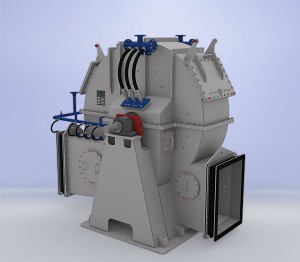 The THEISEN Disintegrator V15 is a rotary wet scrubber simultaneously acting as an ID fan.
The THEISEN Disintegrator V15 is a rotary wet scrubber simultaneously acting as an ID fan.
This combination of gas scrubbing, i.e. highly effective separation of solid particulate matter and water-soluble acidic gas components (e.g. SO2 and HCl), and simultaneous gas pressure increase are the striking characteristic of this machine, making it the first-choice key component of process gas cleaning plants for various applications.
Depending on the Disintegrator design and size, gas volume flow rates of up to 140’000 m3/h are drafted. Usually additional pressure boosting fans are unnecessary due to the pressure increase generated by the Disintegrator of up to 10 kPa. The special model with integrated liquid ring compressor (CDC) even allows for a far higher final pressure.
The THEISEN Disintegrator is utilised in process gas cleaning plants of:
- metallurgical processes, e.g. reduction furnaces, shaft furnaces, etc.
- synthetic gas generators
- power gas generators
- pyrolysis of organic material, e.g. waste, wood, etc.
- calcination processes
- coking plants and furnaces for producing graphite electrodes
The Tasks of the THEISEN Disintegrator
- exhausting of the off-gas emitted by upstream processes
- drafting the process gas through all sections of the gas cleaning plant
- compensating all plant internal pressure losses
- separation of even the finest particulate matter of the process gas to comply with a required clean gas dust content of less than 5 mg/Nm3
- supplying clean gas of required excess pressure to be utilized in downstream consumer systems
Design and Working Principle
The rotating (rotor) and static internals (stator) are concentrically arranged within the spiral housing. The rotor shaft is supported in external bearings, and carries a spraying cylinder and retaining disc with attached rotating impingement-type bar cages. These incorporate the stator, likewise fitted with impingement-type bar cages that are rigidly bolted to the housing walls. The rotor and stator are arranged in such a way that the static and rotating bar rows alternate radially from centre (shaft) to circumference (housing).
The pre-scrubbed dust-laden process gas enters the spiral Disintegrator housing axially and concentrically to the rotor shaft. In parallel washing water is fed to the rotating spraying cylinder, and is evenly distributed over the entire rotor width. Due to the rotation and associated centrifugal forces, the gas-solid-fluid mixture is accelerated in a radial direction and consequently crashes against the stationary impingement bars of the first stator bar row. Due to this impact the washing water is converted into a fine scrubbing mist. As the gas-solid-fluid mixture moves outwards, this process is repeated with each pair of rotating and static bar rows. This continuously generates a huge boundary surface between gas and liquid, characterised by a very high relative velocity between gas, liquid and particles and turbulent flows.
Under these conditions very high separating efficiency rates are achieved. These are also the optimum conditions for absorption of gaseous impurities such as acidic gas components. Whilst process water is usually used as washing liquid, depending on the chemical gas composition, special washing liquids can also be applied, e.g. organic liquids like oil, tar-water-emulsions, heavy oil, etc.
Finally the now dust-laden washing water and cleaned process gas tangentially leave the spiral housing; the separation of liquid and gas taking place in the downstream water separator.
The Result: Optimized Gas Scrubbing in a Unique Machine
- durable compliance with and even significantly exceeding legal emission limits
- supply of high calorific fuel gas without any disturbing impurities for energetic utilization in downstream combustion processes in combustion chambers, gas turbines and gas motors
- integrated self-cleaning property of the process gas “washing machine” Disintegrator due to continuous feeding of washing water
- intrinsically safe (prevention of sparking within the Disintegrator) due to the existence of free water at all times – even in emergency situations
- eliminates sensitive booster fans with limited operating reliability
- optimized scrubbing efficiency of the Disintegrator at all flow rates between 0 and 100% of the nominal capacity
The well-chosen materials as well as the robust design of the Disintegrator ensure a long equipment lifetime at minimized maintenance effort.


